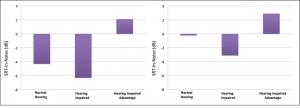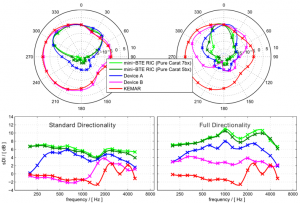Binaural Beamforming and Directionality: Siemens Technology Holds Clear Performance Advantage
By Marc Aubreville, Dipl.-Ing and Stefan Petrausch, PhD
Canadian Audiologist – vol. 2, issue 4, 2015
For the past four decades, directional microphone technology has been the preferred hearing aid solution to help patients understand speech in background noise. Since the inception of directional processing in hearing aids (introduced in Germany in the late 1960s), Siemens has been at the forefront of development and research. Over the past 15 years, independent clinical studies using Siemens instruments have supported the patient benefit that can be obtained from dual-microphone directional instruments,1 a three-microphone directional system,2 adaptive directional microphones,3 an anti-cardioid (rear-facing) directional algorithm,4 and a unique integration of noise reduction and directional processing.5
The most recent development regarding directional hearing aid processing involves wireless communication, which allows for the exchange of audio data received by the microphones of both the right and left hearing aids, which then can be used to achieve narrow beamforming. This new beamforming technology from Siemens, termed Narrow Directionality, was described in detail by Kamkar-Parsi et al.6
Clinical studies at two independent research sites were designed to compare the new Siemens binaural beamformer to a high standard: the speech recognition in background noise performance of normal-hearing individuals for the same listening task. The participants were required to repeat back target sentences from a 0 degree azimuth, while surrounded by background noise (e.g., typical party environment). The results were clear: the hearing-impaired individuals using hearing aids equipped with the binaural beamformers, not only performed equal to normal-hearing individuals, but significantly better. The SRT-In-Noise findings from the two different research sites are displayed in Figure 1. As shown, the SNR advantage was 2–3 dB (significant at <.01); enough to be noticeable in many real-world situations.7
 Figure 1. The SRT-In-Noise mean findings for the two different test sites for the normal hearing and hearing impaired groups. The bar to the far right on each chart represents the SNR advantage for the hearing impaired when fitted with the binaural beamforming instruments (p<.01) (adapted from Powers and Froehlich).7
Figure 1. The SRT-In-Noise mean findings for the two different test sites for the normal hearing and hearing impaired groups. The bar to the far right on each chart represents the SNR advantage for the hearing impaired when fitted with the binaural beamforming instruments (p<.01) (adapted from Powers and Froehlich).7Binaural Beamforming for All Models
The original research with the Siemens binaural beamforming was conducted using the mini-BTE RIC (Receiver-in-Canal) product: the Siemens Pure Carat binax. Narrow Directionality processing has been extended to several other models and within the Siemens product portfolio in 7bx, 5bx, and 3bx performance levels: Siemens mini-BTE Pure binax, and traditional BTE devices Siemens Motion binax, and the custom in-the-ear (ITE) devices (Siemens Insio) with two microphones.
The most recent product to join the binaural beamforming family is the completely-in-the-canal (CIC) device (Siemens Insio 7bx). For the first time, automatic and adaptive directivity can be obtained through wireless audio ear-to-ear transmissions in a single-microphone design. The binaural processing also allows for binaural OneMic directionality; significant attenuation to signals from the sides and much of the rear hemisphere in the wearing position, achieved utilizing the bidirectional audio transmissions (see Aubreville and Petrausch for review8). This processing provides a significant 5.6 dB advantage compared to the common omnidirectional setting.8 Finally, a solution for the patient who wants the highest level of technology, but also the most discreet fitting.
As apparent from the preceding review, Siemens binaural beamforming processing is now available in a wide range of products. While these instruments use the same processing platform, the housing types are very different. The different housings can affect the orientation and spacing of the microphone inlet ports, which can impact directionality. The location of the inlet ports relative to the pinna also can change the degree of directivity. It was, therefore, necessary to develop a method to compare these different products electroacoustically, so that reliable predictions of real world benefit can be made.
Directivity Measures of Modern Hearing Aids
Traditionally, laboratory measures of directional hearing aids have included the directivity index (DI), which is a frequency-specific ratio of the hearing aid output for signals originating from 0 degrees compared to all surrounding signals; usually these measures are taken with the hearing aid mounted on the ear of the KEMAR. For example, a hearing aid with an average DI of 4.0 would suggest that the output of the 0 degree signal was 4 dB greater than the average of all surrounding outputs in a uniform field. The average DI measured on the head is useful in that DI calculations that have been averaged across frequency have been shown to correlate well with behavioral differences in speech recognition in noise.9. As reviewed by Ricketts and Mueller,10 and originally suggested by Killion et al,11 the DI can be modified by adding speech weighting in an attempt to make it a better predictor of real-world performance. The original use of the AI-DI was based on using the importance functions taken from the Mueller-Killion Count-The-Dots audiogram.12 That is, the articulation-index-weighted directivity index (AI-DI) uses band importance weightings to assign more weight to the directional advantages for the frequencies most important for speech recognition.
The traditional DI, however, is only defined for a static behaviour of the system. With modern hearing aids with adaptive technologies it is meaningful to modify the standard DI method. This is accomplished using the calculation of a sequential directivity index (sDI), calculated in octave bands using the interferer-to-target ratio(ITR), as it effectively resembles the inverse SNR benefit of the hearing aid. The aim of the sDI is to provide values that can facilitate comparison between different directional processing schemes. The AI modification to the DI also can be applied to the sDI, resulting in an sAI-DI.8
Comparison of Binaural Processing Technologies
The sDI and the sAI-DI methods described above can be used to compare directional processing of different hearing aids within a manufacturer’s portfolio, or hearing aids from different manufacturers. Laboratory directional measures were conducted with the premier hearing instruments (mini-BTE RICs) of two other leading manufacturers, both of whom claimed binaural directional processing with different technologic realization. Also tested was the Siemens binax mini-BTE RIC devices for two different performance levels (7bx and 5bx; the 7bx considered to be the higher performing instrument). The devices were fit to the KEMAR, and programmed using each manufacturer’s standard first fit procedure for a 40 dB flat hearing loss and closed acoustic coupling. Compression ratios were set to 1:1 in all devices, and the feedback cancellation was turned off. Testing was conducted in both the standard directional and full directional (i.e., the maximum level of directionality) mode.
Displayed in the upper portion of Figure 2, are the ITRs at 1000 Hz for the four different instruments and the open ear of the KEMAR. The lower portion of Figure 2 shows the sDIs for these five measures for both the standard directional and full directional modes. Observe that for the standard directional setting (left panel), the two Siemens products have an sDI around 5.0 to 6.0 dB across frequencies, with slightly better performance for the 7bx (sAI-DI=5.7 dB compared to sAI-DI=5.3 dB for the 5bx). Device A falls below these values (sAI-DI=3.9 dB), and Device B (sAI-DI=0.8 dB) seems to only have directional benefit for the high frequencies, and is only 1.2 dB better than the unaided open ear (sAI-DI=-0.4 dB).
 Figure 2. The top portion of this figure shows the Interferer-to-Target Ratio(ITRs) for four different products (fitted to the left ear of the KEMAR) and the ITRs for the KEMAR open ear. The left top panel contains measures from the standard directional setting; the right top panel is for a full directional setting. The bottom portion of the chart shows the corresponding sDI calculations across frequencies for the same four products and the two different settings (the KEMAR open-ear sDI is included as reference).
Figure 2. The top portion of this figure shows the Interferer-to-Target Ratio(ITRs) for four different products (fitted to the left ear of the KEMAR) and the ITRs for the KEMAR open ear. The left top panel contains measures from the standard directional setting; the right top panel is for a full directional setting. The bottom portion of the chart shows the corresponding sDI calculations across frequencies for the same four products and the two different settings (the KEMAR open-ear sDI is included as reference).In the full directional mode (see lower right panel of Figure 2), observe that the Siemens devices now have an sDI in the 8.0 to 10.0 dB range for most frequencies, and again, there is slight difference between the two products (sAI-DIs of 9.2 and 8.7 dB). The sDI of Device A is improved from the standard directional setting, but still falls 2.0 dB or more below the Siemens products for most frequencies (sAI-DI=6.1 dB). Device B (sAI-DI=3.0 dB) clearly performs only monaural beamforming, having directionality for this setting that is still poorer than what the other devices had in the standard directional mode. Comparing the three devices with true binaural beamforming, there is a clear difference in directionality, with an increase from Device A to the Siemens mini-BTE RIC Pure Carat 5bx to the Siemens mini-BTE RIC Pure Carat 7bx.
Fully Automatic and Integrated
While the laboratory electroacoustic directivity is impressive, it is also important that this processing operates effectively and efficiently in the real world. It is important to note that Narrow Directionality and binaural OneMic directionality are fully integrated into the automatic program and shifts seamlessly from the standard directional microphone mode to provide the appropriate directional setting for various listening situations. Linked to the advanced signal classification system, it activates and deactivates automatically when necessary, and provides a smooth transition between these two states to maintain optimal sound quality—even in the transition phase. Benefits to the user include no need for manual adjustments with minimal battery consumption.7
In Closing
While the original design might be from the 1960s, directional technology continues to improve each year, and Siemens has been a consistent leader in this area for the past four decades. Most recently, binaural beamforming using wireless audio transmissions has taken this processing to a new level, and this technology is now available in a wide range of products, including CICs. As shown here, Siemens binaural beamforming products produce exceptionally high sDIs, and significantly outperform other products purporting to have this technology.
References
- Ricketts T, Dhar S. Comparison of performance across three directional hearing aids. J Am Acad Audiol 1999;10(4):180–89.
- Bentler RA, Palmer C, Dittberner AB. Hearing-in-noise: comparison of listeners with normal and (aided) impaired hearing. J Am Acad Audiol 2004;15(3):216–25.
- Ricketts TA, Hornsby BW, Johnson EE. Adaptive directional benefit in the near field: competing sound angle and level effects. Seminars in Hearing 2005;26(2):56–69.
- Mueller HG, Weber J, Bellanova M. Clinical evaluation of a new hearing aid anti-cardioid directivity pattern. Int J Audiol 2011;50(4):249–54.
- Powers T, Beilin J. True advances in hearing aid technology: what are they and where’s the proof? Hear Rev 2013;20(1).
- Kamkar-Parsi H, Fischer E, Aubreville M. New binaural strategies for enhanced hearing. Hear Rev 2014;21(10):42–45.
- Powers TA, Froehlich M. clinical results with a new wireless binaural directional hearing system. Hear Rev 2014;21(11):
- Aubreville M, Petrausch S. Measuring directionality of modern hearing aids. Canadian Audiologist 2015;2(3). Available at: http://canadianaudiologist.ca/issue/volume-2-issue-3-2015/measuring-directionality-of-modern-hearing-aids/.
- Ricketts TA, Henry P, Hornsby BWY. Application of frequency importance functions to directivity for prediction of benefit in uniform fields. Ear Hear 2005;26(5):473–86.
- Ricketts T and Mueller HG. Making sense of directional microphones. Am J Audiol 1999:8:117–26.
- Kilion M, Schulien R, Christensen L, Fabry D, Revit L, Niquette P, Chung K. Real world performance of an ITE directional microphone. Hearing J 1998:51(4):24–38.
- Mueller HG and Killion M. An easy method for calculating the articulation index. Hearing J 1990:43(9):14–17.

